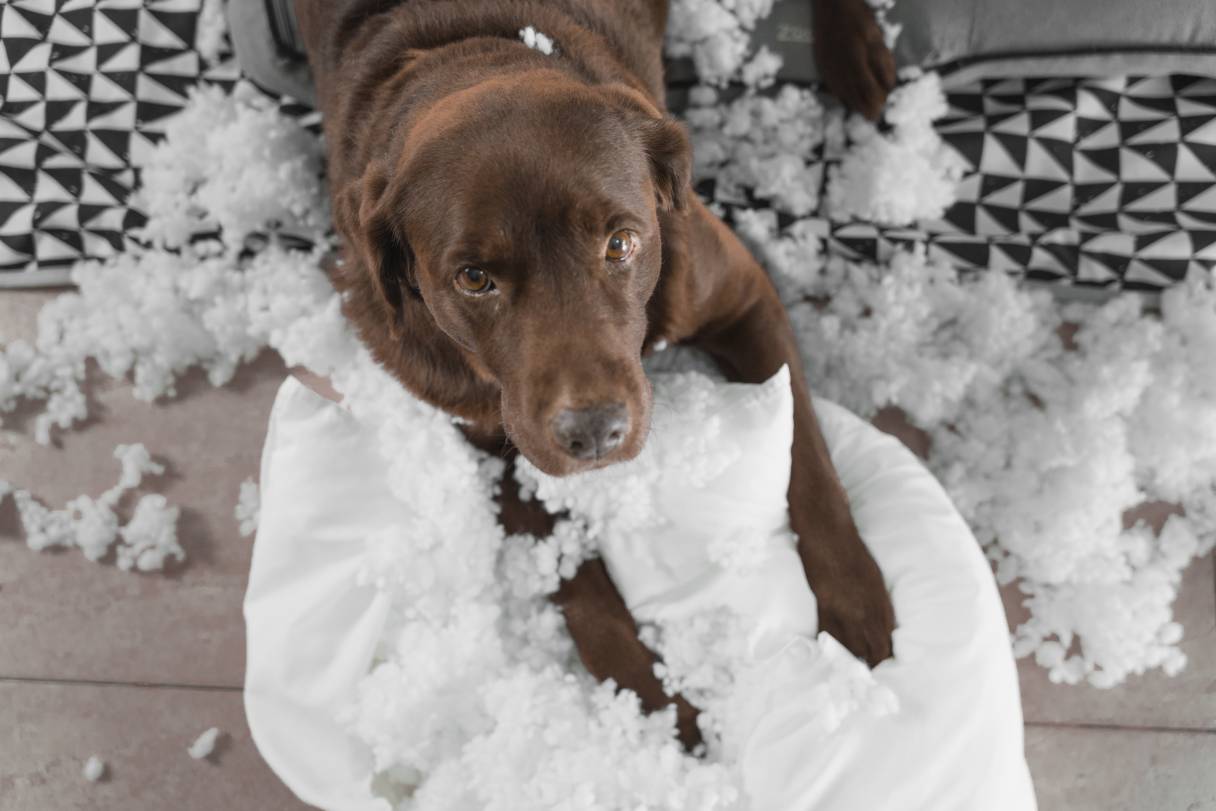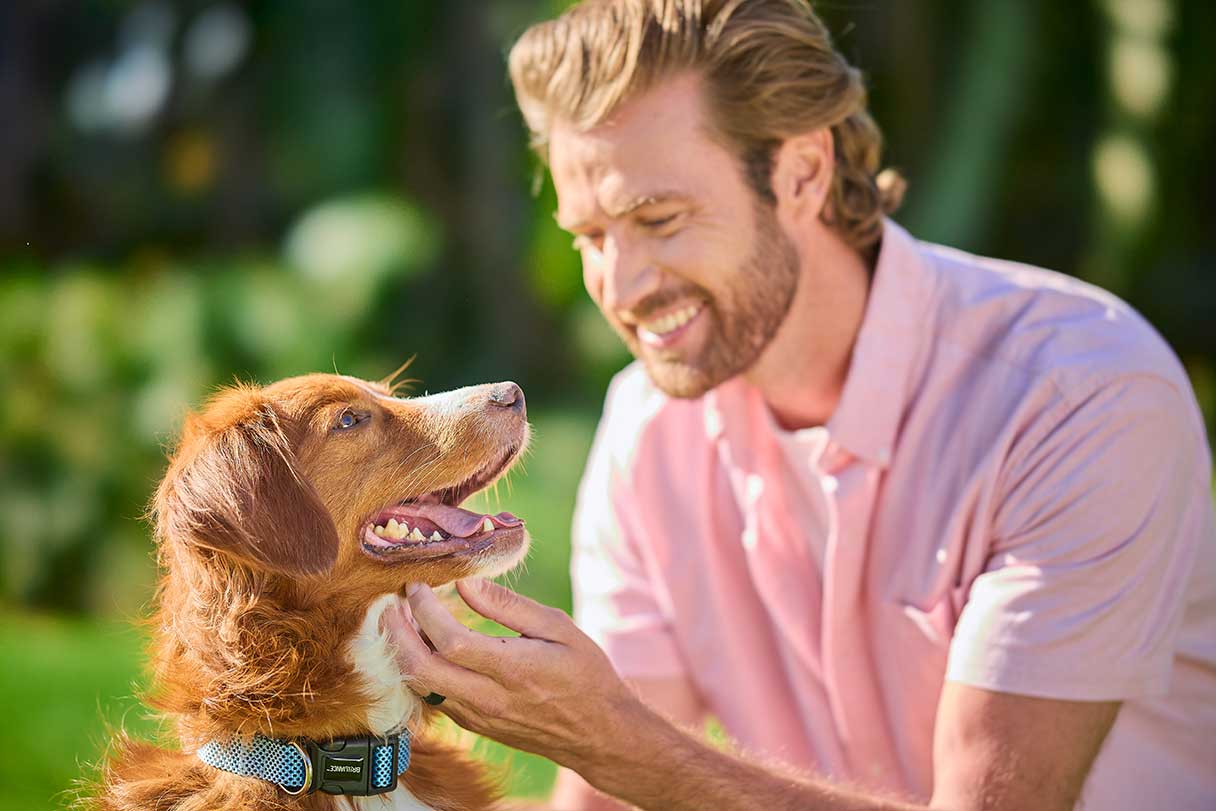No one likes saying goodbye to their dog, but if your dog goes crazy whenever you leave the house to go to work or run errands, you could be dealing with separation anxiety. And you're not alone — around 86% of dogs enrolled in the Dog Aging Project (DAP) in the United States show signs of separation anxiety.1
This article will discuss separation anxiety, why it happens and how you can help alleviate your dog's stress when you aren't with them 24/7.
What Is Separation Anxiety in Dogs?
Dogs with separation anxiety experience intense fear, similar to a panic attack in humans, when they are separated from their owner. This goes beyond the usual sadness that occurs with many dogs when an owner leaves the home — they become mildly sad but not stressed out and can calmly deal with the separation until the owner returns. Dogs with separation anxiety often stay abnormally close to their owner when they are home and can become wildly destructive when left alone.
Not all dogs with separation anxiety experience the same level of distress when separated from their pet parents. Generally, separation anxiety is separated into three types:
- Mild, also known as separation intolerance
- Moderate
- Severe
Generally, the more severe your dog's separation anxiety, the greater their reaction to your departure and the more destructive they can become.
Common causes
There are many potential causes of separation anxiety in dogs, with most related to some type of change in the household or a disruption to your dog's usual routine. Common causes include:
- New owner. If your dog has recently been adopted from a shelter or rehomed with a new owner, the experience could trigger separation anxiety. In fact, separation anxiety is more common in shelter dogs than in those raised by one owner since birth.
- Moving homes. Simply relocating to a new home with your dog could trigger separation anxiety due to their new, unfamiliar surroundings.
- Loss of a family member. If someone in your household moves out or passes away, your dog may develop separation anxiety as a result of their loss, especially if they were very close to that person.
- Schedule changes. Being left alone for longer periods or a major change, such as a job change after working from home, can lead to separation anxiety.
- Traumatic events. Dogs who go through a traumatic event, such as a natural disaster or spending an extended time in a boarding kennel, can later develop separation anxiety.
Signs a Dog May Have Separation Anxiety
The mental anguish that separation anxiety causes for your dog will manifest itself through certain behaviors, which can be destructive. While occasionally having an accident or chewing your favorite slipper doesn't necessarily indicate separation anxiety, your pup may be affected if they regularly exhibit symptoms.
Signs of separation anxiety in dogs can include:
- Pacing, whining or trembling. These behaviors often begin when your dog realizes you are going to leave and continue while you are away.
- Drooling or panting. Anxious dogs often drool or pant when left alone.
- Refusal to eat. Dogs with severe separation anxiety may refuse to eat when you are away from home.
- Eating feces (coprophagia). Dogs with separation anxiety may eat their own feces when you aren't present.
- Eliminating in the home. While the occasional accident isn’t concerning, dogs with separation anxiety commonly become so anxious that they can’t hold it.
- Excessive vocalization. Dogs with separation anxiety often bark, whine or howl for long periods when their owners are away.
- Destructive behaviors. The severe stress caused by separation anxiety can lead to destructive behaviors, such as chewing your belongings or destroying furniture.
- Escape attempts. Your dog's attachment might be so great that when you aren't home, they will desperately try to escape and find you. These destructive escape attempts might result in significant household damage and even self-harm, such as scraped paws and broken teeth.
If you have noticed one or more of the behaviors associated with separation anxiety, visit your veterinarian to rule out illness as the cause. After your veterinarian rules out a medical reason for your dog's behavior, they can consider the possibility of separation anxiety. In order to definitively diagnose your dog with separation anxiety, your veterinarian may want to see a video of your dog's behavior when they are left home alone.
To record your dog’s behavior when you’re not home, set up one or more Wi-Fi-accessible video cameras in your home. Motion-activated cameras work best to capture behaviors such as pacing, inappropriate elimination, escape attempts and destructive chewing. Then, leave your home as you normally would and use the cameras to record your dog’s behavior.
Share the videos with your veterinarian and let them know if any of the abnormal behaviors also occur when you are home.
Helping a Dog With Separation Anxiety
Fortunately, separation anxiety is a treatable condition. Delaying or avoiding treatment is not a good idea, as separation anxiety doesn’t resolve on its own and typically worsens over time. Treatment often involves using several methods together as part of a multi-modal treatment plan.
Crate training
Your dog's crate can provide a cozy haven, helping them feel safe when they are alone. Train your dog to eat in their crate and save their favorite chew toys and treats for crate time. This will help them form positive associations with their crate.
While crate training can help some dogs with separation anxiety, others may panic when left in the crate when you are not home. Panicked escape attempts may lead them to harm themselves. Using a video camera to observe your dog when they are in the crate can help you determine whether it's a help or a hindrance.
Counterconditioning
Dogs with separation anxiety associate your departure and absence with negative emotions. Counterconditioning involves helping them associate positive experiences with your absence. Methods you can try include:
- Give special treats. When leaving, give your dog a high-value treat, like peanut butter or cheese in a long-lasting chew toy. This will distract them during your departure and help keep them calm during your absence.
- Use puzzle feeders. Feeding your dog kibble in a puzzle toy can also help occupy their time while you're away.
- Leave your scent. Placing some of your recently worn clothing in your dog's crate can help soothe them while you are gone.
- Provide background noise. Listening to the television or radio can help your dog feel less lonely.
- Invest in a treat-dispensing video camera. This technology allows you to reward your dog for good behavior and check in on them when you're not home.
The goal of these counterconditioning measures is for your dog to be occupied with pleasant things while you're away, easing their anxiety. Note that some dogs with severe separation anxiety may not respond to treats because they will generally refuse to eat when you are away.
Desensitization
Many dogs begin to get anxious the moment they realize you are preparing to leave. They recognize activities such as putting on your shoes and grabbing your keys as cues that you are leaving and start to get worked up. Desensitizing your dog to these cues can help them stay calm when you leave. To desensitize your dog, try these methods:
- Perform the tasks you normally do before you leave, such as grabbing your car keys, without leaving. Instead, give your dog a treat.
- Place your dog in their crate, or a separate room if the crate makes them nervous, while you get ready to go.
- Leave for small increments of time, returning before your dog's anxiety starts to increase. Gradually extend this time each day.
- Keep returns low-key by avoiding excitement when you walk in the door. Instead, do your best to ignore your dog's enthusiastic greetings and save interactions for once they calm down.
Exercise
A lack of exercise can contribute to separation anxiety. If your dog has a lot of pent-up and nervous energy when you leave, it can set them up for a negative experience. Use these tips to help your dog feel calmer when they are left alone:
- Exercise your dog before leaving. A vigorous, 20- to 30-minute exercise session can help tire out your dog before you leave so they can relax while you're gone.
- Provide mental stimulation. Provide mental exercise in the form of daily basic obedience and trick training. You can also take your dog to a professional training class.
- Use interactive toys. Provide your dog with interactive dog toys that will engage their brain while you're away.
Calming aids
Along with crate training, counterconditioning, desensitization and exercise, you can use calming aids to soothe your dog while you're away. Examples of calming aids include:
- Calming treats. Choose treats that contain ingredients like CBD, chamomile, passionflower, L-theanine, melatonin and L-tryptophan.
- Calming vests. Calming vests wrap around your dog and provide a sense of security, much like a hug.
- Calming pheromones. Made from synthetic versions of the hormones female dogs release to calm newborn puppies, pheromone products include diffusers, sprays and collars. These products can be used alone or together for a synergistic effect.
- Comfy bed. Ensure your dog has a bed where they can comfortably relax while you're away.
Prescription medication
Prescription medication can help dogs with severe separation anxiety deal with being alone by relieving their anxiety and keeping them calm. Anti-anxiety medications your vet may prescribe include:
- Amitriptyline
- Fluoxetine
- Alprazolam
- Dexmedetomidine
- Buspirone
- Clomipramine
- Diazepam
Tips to Help Prevent Separation Anxiety in Dogs
There's no surefire way to completely prevent separation anxiety from developing. However, keeping a regular routine for your dog provides a sense of security and can go a long way toward preventing the condition.
These tips may prevent your dog's anxiety from ramping up to harmful levels and becoming a bigger problem down the road. They can also help when combined with counterconditioning and desensitization.
1. Take your dog to daycare
Most dogs with separation anxiety will be happy if they aren't left alone during the day and doggy daycare provides them with a fun, safe alternative. Plus, not only will they get to spend time with people, they can make some fellow canine friends and get lots of exercise, too.
2. Use a dog walker
With counterconditioning and desensitization, some dogs will be able to handle being alone for a few hours. But, leaving them by themselves for up to eight hours while you're at work could induce a panic attack.
Have a dog walker stop by once or twice a day while you're at work. These breaks will provide your dog with the companionship they need and give them much-needed exercise.
3. Take your dog to work
Some offices are pet-friendly and allow you to bring your furry friend to work with you rather than leaving them unattended all day. Not only will your dog be near their favorite person, but socializing with your coworkers can help minimize their stress and brighten their day.
Managing and Preventing Separation Anxiety in Dogs
Separation anxiety is a common condition in dogs that causes intense distress when left alone, often triggered by changes in their environment or routine. Recognizing the signs early and using a combination of treatments — such as training, calming aids and sometimes medication — can help manage the condition. Preventive steps like maintaining routines and providing companionship also play a key role in reducing anxiety and improving a dog’s well-being.
CareCredit Credit Card Financing for Dogs
Taking good care of your pet's well-being from nose to tail is essential. Make sure to stay up to date on their regular checkups at the vet to help keep your pet happy and healthy for a lifetime of love. You can use your CareCredit credit card for pet care throughout the year for routine veterinary services as well as emergencies and surgeries.* Use our Acceptance Locator to find a veterinarian near you that accepts CareCredit.
CareCredit is there for you and your pet every step of the way; continue your wellness journey by downloading the CareCredit Mobile App to manage your account, find a provider on the go and easily access the Well U blog for more great articles, podcasts and videos.
In addition to pet care, you can also use your CareCredit credit card for dentistry, cosmetic, vision, hearing, health systems, dermatology, pharmacy purchases, spa treatments and so much more within the CareCredit network. How will you invest in your health and wellness next?
Author Bio
Angela Beal, D.V.M., has more than 20 years of experience as a veterinarian. Leveraging her background in private practice and academia, she uses her passion for writing to convey information to pet owners to help them keep their pets healthy and happy.







